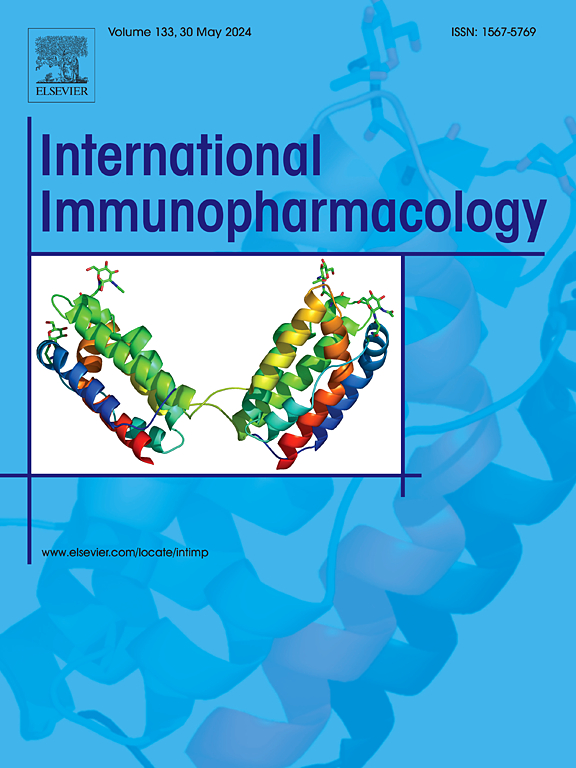芥子气暴露下外周血单个核细胞的综合转录组学分析
IF 4.7
2区 医学
Q2 IMMUNOLOGY
引用次数: 0
摘要
硫磺芥子气(SM)是一种会引起水泡的物质,伊拉克在化学战争中多次使用它来对付10万多名伊朗人。这些人的主要问题是各种肺部问题,类似于慢性阻塞性肺疾病(COPD)。材料和方法本研究利用RNA-seq技术在BGISEQ平台上分析了健康对照(HC)受试者中三组(重度、中度和轻度)芥菜肺(ML)患者外周血单个核细胞(PBMCs)分离的总RNA谱(配对端,7gb数据,rRNA耗散)。然而,鉴于重症组在临床问题中的重要性,我们优先研究这一组。用limma包获得重症组与HC的差异表达基因(DEGs)。通过生物信息学工具对deg进行分析,并对其基因本体(GO)和富集分析(EA)进行评价。然后,使用String-db和Cytoscape工具搜索最重要的功能基因。结果采用hub和瓶颈标准鉴定出SERPINA1、MAPK3、MMP9、FOXO3、SLC4A1、FCGR3B、CXCR2、PTGS2、HBA2、GPX1、IL1RN、IFNG、RPS29、CXCL1、FPR1和RPS9基因。基于对重要基因的分析,确定了几种生物学途径,包括先天免疫、炎症反应、中性粒细胞活化、细胞因子反应、氧化应激反应、脂氧合酶途径和巨噬细胞分化。结论先天性免疫和中性粒细胞在这些个体的发病机制中起重要作用。白细胞介素4、10和13的信号通路刺激肺巨噬细胞(MQs)分化为M2,这是修复、重塑和炎症所必需的。此外,活性氧(ROS)通过磷酸肌肽3激酶(PI3K)激活蛋白激酶B (PKB),也就是AKT,增加活化B细胞的核因子κ轻链增强子(NF-κB)的活性,导致组蛋白去乙酰化酶2 (HDAC2)的降低是这些患者病理生理的重要途径之一。本文章由计算机程序翻译,如有差异,请以英文原文为准。
Comprehensive transcriptomics analysis of peripheral blood mononuclear cells in exposure to mustard gas
Introduction
Sulfur mustard (SM) is a substance that causes blisters and has been repeatedly used by Iraq in chemical warfare against more than 100,000 Iranians. The main issue for these people is various pulmonary problems similar to chronic obstructive pulmonary disease (COPD).
Materials and methods
Our study analyzed the total RNA profile extracted using the RNA-seq technique from peripheral blood mononuclear cells (PBMCs) isolated from Mustard Lung (ML) patients of all three groups (Severe, Moderate, and Mild) in terms of disease in healthy control (HC) subjects on the BGISEQ platform (Paired-end, 7 GB data, and rRNA depletion). However, given the severe group’s importance in clinical problems, we prioritized studying this group. Differentially expressed genes (DEGs) of the severe group versus HC were obtained using the limma package. DEGs were analyzed through bioinformatics tools, and their gene ontology (GO) and enrichment analysis (EA) were evaluated. Then, String-db and Cytoscape tools were used to search for the most important functional genes.
Results
We identified SERPINA1, MAPK3, MMP9, FOXO3, SLC4A1, FCGR3B, CXCR2, PTGS2, HBA2, GPX1, IL1RN, IFNG, RPS29, CXCL1, FPR1, and RPS9 genes using hub and bottleneck criteria. Based on the analysis of important genes, several biological pathways were identified, including innate immunity, inflammatory response, and activation of neutrophils, cellular response to cytokines, and cellular response to oxidative stress, lipoxygenase pathway, and macrophage differentiation.
Conclusion
Innate immunity and neutrophils play a crucial role in the pathogenesis of these individuals. The signaling pathways of interleukins 4, 10, and 13 stimulate the differentiation of lung macrophages (MQs) into M2, essential for repair, remodeling, and inflammation. Additionally, reactive oxygen species (ROS) activate Protein kinase B (PKB), also known as AKT, through Phosphoinositide 3-kinases (PI3K) and increase the activity of nuclear factor kappa-light-chain-enhancer of activated B cells (NF-κB), which results in decreased histone deacetylase 2 (HDAC2) being one of the important pathways of pathophysiology in these patients.
求助全文
通过发布文献求助,成功后即可免费获取论文全文。
去求助
来源期刊
CiteScore
8.40
自引率
3.60%
发文量
935
审稿时长
53 days
期刊介绍:
International Immunopharmacology is the primary vehicle for the publication of original research papers pertinent to the overlapping areas of immunology, pharmacology, cytokine biology, immunotherapy, immunopathology and immunotoxicology. Review articles that encompass these subjects are also welcome.
The subject material appropriate for submission includes:
• Clinical studies employing immunotherapy of any type including the use of: bacterial and chemical agents; thymic hormones, interferon, lymphokines, etc., in transplantation and diseases such as cancer, immunodeficiency, chronic infection and allergic, inflammatory or autoimmune disorders.
• Studies on the mechanisms of action of these agents for specific parameters of immune competence as well as the overall clinical state.
• Pre-clinical animal studies and in vitro studies on mechanisms of action with immunopotentiators, immunomodulators, immunoadjuvants and other pharmacological agents active on cells participating in immune or allergic responses.
• Pharmacological compounds, microbial products and toxicological agents that affect the lymphoid system, and their mechanisms of action.
• Agents that activate genes or modify transcription and translation within the immune response.
• Substances activated, generated, or released through immunologic or related pathways that are pharmacologically active.
• Production, function and regulation of cytokines and their receptors.
• Classical pharmacological studies on the effects of chemokines and bioactive factors released during immunological reactions.

 求助内容:
求助内容: 应助结果提醒方式:
应助结果提醒方式:


